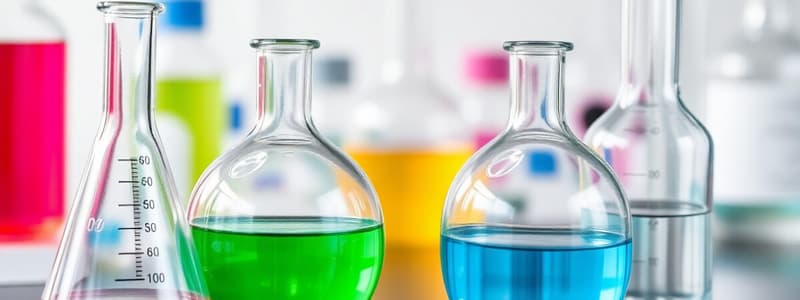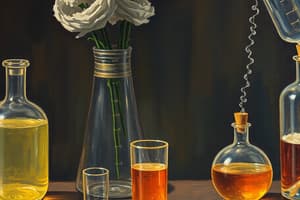Podcast
Questions and Answers
What is the Rf value of a substance that travels 4 cm while the solvent travels 8 cm?
What is the Rf value of a substance that travels 4 cm while the solvent travels 8 cm?
- 4
- 2
- 0.5 (correct)
- 0.25
Which of the following gases can be identified by its ability to relight a glowing splint?
Which of the following gases can be identified by its ability to relight a glowing splint?
- Hydrogen
- Chlorine
- Oxygen (correct)
- Carbon dioxide
Which of the following is NOT a greenhouse gas?
Which of the following is NOT a greenhouse gas?
- Carbon dioxide (CO₂)
- Nitrogen (N₂) (correct)
- Methane (CH₄)
- Water vapor (H₂O)
What is the main source of oxygen in Earth's atmosphere?
What is the main source of oxygen in Earth's atmosphere?
Which of these is NOT a finite resource?
Which of these is NOT a finite resource?
What is the main purpose of Life Cycle Assessment (LCA)?
What is the main purpose of Life Cycle Assessment (LCA)?
Which of these is a step in water treatment that removes solids?
Which of these is a step in water treatment that removes solids?
What is the main product of the Haber Process?
What is the main product of the Haber Process?
A reversible reaction is at equilibrium. What happens to the rate of the forward reaction if the concentration of the products is increased?
A reversible reaction is at equilibrium. What happens to the rate of the forward reaction if the concentration of the products is increased?
Which of the following is NOT a factor that affects the rate of a chemical reaction?
Which of the following is NOT a factor that affects the rate of a chemical reaction?
What is the main difference between complete and incomplete combustion?
What is the main difference between complete and incomplete combustion?
Which of the following is an example of a condensation polymer?
Which of the following is an example of a condensation polymer?
What is the main purpose of fractional distillation in the refining of crude oil?
What is the main purpose of fractional distillation in the refining of crude oil?
What is the functional group present in carboxylic acids?
What is the functional group present in carboxylic acids?
Which of the following techniques can be used to separate substances based on their solubility?
Which of the following techniques can be used to separate substances based on their solubility?
Which of the following is a natural polymer?
Which of the following is a natural polymer?
Flashcards
Rf value
Rf value
Ratio of distance moved by substance to distance moved by solvent.
Tests for Hydrogen gas
Tests for Hydrogen gas
Lit splint creates a squeaky pop when hydrogen is present.
Tests for Oxygen gas
Tests for Oxygen gas
Glowing splint relights in the presence of oxygen.
Tests for Carbon dioxide
Tests for Carbon dioxide
Signup and view all the flashcards
Finite vs. Renewable Resources
Finite vs. Renewable Resources
Signup and view all the flashcards
Life Cycle Assessment (LCA)
Life Cycle Assessment (LCA)
Signup and view all the flashcards
Desalination
Desalination
Signup and view all the flashcards
Haber Process (Ammonia)
Haber Process (Ammonia)
Signup and view all the flashcards
Rates of Reaction
Rates of Reaction
Signup and view all the flashcards
Collision Theory
Collision Theory
Signup and view all the flashcards
Dynamic Equilibrium
Dynamic Equilibrium
Signup and view all the flashcards
Le Chatelier’s Principle
Le Chatelier’s Principle
Signup and view all the flashcards
Fractional Distillation
Fractional Distillation
Signup and view all the flashcards
Complete Combustion
Complete Combustion
Signup and view all the flashcards
Unsaturated Hydrocarbons
Unsaturated Hydrocarbons
Signup and view all the flashcards
Addition Polymerisation
Addition Polymerisation
Signup and view all the flashcards
Study Notes
Rates of Reaction & Equilibrium
- Factors Affecting Reaction Rate: Temperature, concentration, surface area, and catalysts all influence reaction speed.
- Collision Theory: Reactions require collisions with sufficient energy (activation energy).
- Catalysts: Lower activation energy, accelerate reactions without being consumed.
- Measuring Reaction Rate: Measured via volume of gas produced, mass change, or time taken for reactant disappearance.
- Reversible Reactions & Equilibrium: Reactions can progress in both directions.
- Dynamic Equilibrium: Reached when forward and reverse reaction rates are equal.
- Le Chatelier's Principle: Shifting the balance of a reaction response to change:
- Increased temperature favors the endothermic reaction.
- Increased pressure favors the side with fewer gas molecules.
- Concentration change shifts towards the opposing concentration.
Crude Oil and Fuels
- Crude Oil: Mixture of hydrocarbons (primarily alkanes - CnH₂n+₂).
- Fractional Distillation: Separates hydrocarbons based on boiling points.
- Fractions: Refinery gases, petrol, kerosene, diesel, and bitumen.
- Combustion (Complete): Hydrocarbon + oxygen → carbon dioxide + water.
- Combustion (Incomplete): Produces carbon monoxide (toxic) and soot.
- Cracking: Breaks down long-chain alkanes into shorter alkanes and alkenes, using heat and catalysts/steam.
Organic Reactions
- Alkanes: Saturated hydrocarbons (single bonds), largely unreactive (except for combustion).
- Alkenes: Unsaturated hydrocarbons (double bonds), highly reactive. React with bromine water, causing it to decolorize. Used in polymer creation.
- Alcohols: Contain the -OH functional group.
- Ethanol Production: Fermentation (glucose → ethanol + CO₂) or ethene hydration.
- Carboxylic Acids: Contain the -COOH functional group. React with metals and carbonates to form salts.
- Esters: Formed by combining carboxylic acids and alcohols. Used in fragrances and food flavorings.
Polymers
- Addition Polymerisation: Alkenes form long chains (polymers) by linking together. (e.g., poly(ethene), poly(propene).
- Condensation Polymerisation: Two different monomers combine, creating a polymer and a small molecule (like water) (e.g., polyesters, polyamides like nylon).
- Natural Polymers: DNA, proteins, and carbohydrates (starch, cellulose).
Chemical Analysis
- Pure Substance: Single element or compound;
- Formulations: Mixtures for a specific function (e.g., paint, medicine).
- Chromatography: Separates substances via solubility differences.
- Rf Value: Ratio of distance travelled by substance/distance travelled by solvent.
- Tests for Gases:
- Hydrogen: Lit splint → Squeaky Pop.
- Oxygen: Relights glowing splint.
- Carbon dioxide: Turns limewater cloudy.
- Chlorine: Bleaches damp litmus paper.
The Earth's Atmosphere
- Evolution of Atmosphere: Earliest atmosphere was largely CO₂, with little oxygen. Photosynthesis increased oxygen, decreasing CO₂. Carbon is stored in fossil fuels and rocks.
- Greenhouse Gases: CO₂, CH₄ (methane), and H₂O trap heat, causing global warming.
- Climate Change Effects: Melting ice caps, rising sea levels, extreme weather.
- Climate Change Mitigation: Renewable energy, carbon capture, reduced fossil fuel use are response strategies.
The Earth's Resources & Sustainability
- Finite Resources: Limited supply (e.g., fossil fuels, metals).
- Renewable Resources: Naturally replenished (e.g., solar energy, fresh water).
- Life Cycle Assessment (LCA): Evaluating environmental impact through stages: extraction, manufacturing, use/transport, and disposal.
- Sustainability Principles: Reduce, reuse, recycle, minimizing environmental damage.
- Water Treatment: Processes for making potable water safe to drink (filtration, sterilization).
- Desalination: Removes salt from seawater (distillation or reverse osmosis).
Making Ammonia & Fertilisers (Haber Process)
- Haber Process: Creating ammonia (N₂ + 3H₂ ⇌ 2NH₃).
- Conditions: 450°C, 200 atm pressure, iron catalyst; a balance between reaction speed and yield.
- Ammonia Use: Primary component of fertilizers (ammonium nitrate, ammonium sulfate, ammonium phosphate).
- Fertiliser Effects: Increased crop yield but potential environmental impact. (eutrophication is a consequence).
Studying That Suits You
Use AI to generate personalized quizzes and flashcards to suit your learning preferences.




